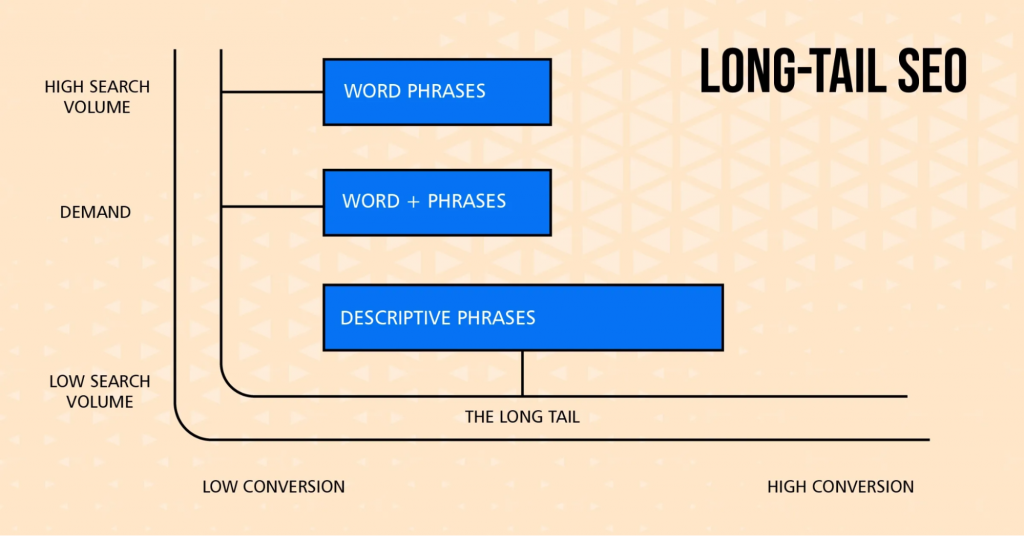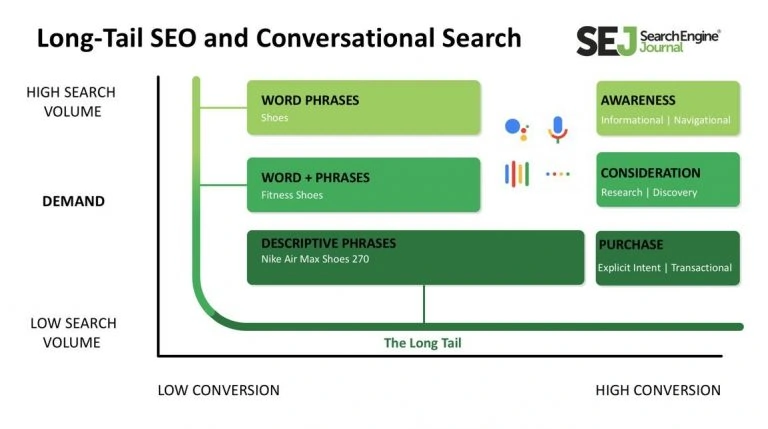You’ve probably heard the term “long-tail keywords,” but what exactly are they, and why do SEO experts talk about them so much? Think of them as your secret weapon in the world of online marketing. While everyone else is fighting over a few popular, generic keywords, you can attract a steady stream of highly qualified visitors by focusing on the specific phrases your customers are actually using.
In this guide, we’ll break down exactly what long-tail keywords are and how they can supercharge your SEO strategy, from attracting the right traffic to building a powerful brand presence.
What are Long-tail keywords?
Long-tail keywords are highly specific, multi-word phrases that people use when they are searching for something very particular. Unlike “head keywords” which are short, broad, and have high search volume (e.g., “coffee”), long-tail keywords are much more focused and often have lower search volume.
The name “long-tail” comes from a statistical concept, where the majority of searches fall into a “long tail” of unique, specific queries, while a small number of broad keywords make up the “head” of the curve.
Key Characteristics of Long-Tail Keywords:
- Specificity: They target a niche topic or a specific user intent. For example, instead of “running shoes,” a long-tail keyword might be “best waterproof running shoes for trail running.”
- Lower Competition: Because they are so specific, fewer websites are competing to rank for them, making it easier for your content to appear high in search results.
- Higher Conversion Rate: People who use long-tail keywords are often closer to making a purchase or taking a specific action. Someone searching for “buy waterproof running shoes for trail running” is much more likely to convert than someone searching for the general term “running shoes.”
- Reflect Natural Language: With the rise of voice search and conversational AI, people are using more natural, question-based queries (e.g., “How do I fix a leaky faucet?”). These queries are, by nature, long-tail.
Related Blog: SEO Keyword: A Complete Guide
How Do Long-tail keywords Work?
Think of it like this: most people, when they first start searching for something, use a really general term—what we in the business call a “head keyword.” It’s like asking a friend, “Hey, what about movies?” They have no idea what you’re really interested in, right? It could be anything.
But then, as you get a clearer idea of what you want, your questions get more specific. You might ask, “What about that new superhero movie coming out?” or “Where can I watch old sci-fi movies for free?” These more specific, multi-word phrases are what we call long-tail keywords. They’re like you’re having a real conversation with the search engine.
Now, here’s the crazy part, and this is where the 80/20 rule comes in.
The Rule Explained
The name “long tail” comes from a visual representation of keyword popularity. If you were to plot all search queries on a graph, you would see a very tall, narrow “head” and a very long, low “tail”.
- The Head (The 20%): A small number of very popular, generic keywords like “coffee” or “shoes” make up the “head” of the graph. These keywords have high search volume and fierce competition. However, they only account for a surprisingly small portion of all search traffic.
- The Long Tail (The 80%): The “tail” represents millions of highly specific, multi-word queries like “best organic Ethiopian coffee beans for espresso” or “waterproof running shoes for trail running.” Each of these individual keywords has a very low search volume, but collectively, they account for the vast majority of all search traffic.
You’d think those general, one or two-word keywords would bring in most of the traffic. But it’s actually the other way around. A few popular keywords get a lot of searches, but they make up a very small part of the total searches. The real gold is in the “long tail.”
Believe it or not, about 70% of all search traffic comes from this long, long tail of specific queries. And the SEO platform Backlinko also found in a study of 306 million keywords that 91.8% of all search queries are long-tail. So, by creating content that answers these specific questions, you’re not fighting with everyone else for the same generic keywords. You’re giving people exactly what they’re looking for, which means they’re much more likely to click on your link and find what they need. It’s about being a problem-solver, not just a brand.
Why are Long-tail keywords in SEO Important, exactly?
Long-tail keywords are one of the most powerful and effective tools in the search engine optimization industry. They are important because they are the key to a targeted, high-value, and cost-effective SEO strategy. Here’s why they are so crucial:
1. They Bring in High-Quality, Relevant Traffic
Unlike a broad, generic keyword, a long-tail keyword shows a very specific user intent. The person searching for “best lightweight laptops under $1,000” is much closer to making a purchase than someone searching for “laptops.” By creating content that directly answers these specific queries, you attract visitors who are genuinely interested in what you have to offer, which leads to higher engagement and conversions.

2. Less Competition, Easier to Rank
Trying to rank for a high-volume head keyword is incredibly difficult, especially for smaller businesses or new websites, as you’re competing against industry giants with massive authority. Long-tail keywords, on the other hand, have less competition, making it far easier to get your content on the first page of search results. You can establish your expertise in a niche and build authority over time.
3. They Make Up the Majority of Searches
While a single long-tail keyword may have a low search volume, when you add them all up, they account for a significant portion of all search traffic. According to statistics from sources like Moz and Embryo, over 70% of all search queries are long-tail terms. This means that a comprehensive long-tail strategy can generate a huge amount of cumulative traffic.
4. They’re Perfect for Voice and AI Search
As people use voice assistants like Siri and Google Assistant, their search queries become more conversational and natural. Instead of typing “weather,” they might ask, “What’s the weather forecast for today in Boston?” Long-tail keywords perfectly align with this trend, making your content more likely to be found as people talk to their devices.
5. Cost-Effectiveness in PPC (Pay-Per-Click)
When you run paid ad campaigns (SEM), bidding on broad, head keywords like “digital camera” is incredibly expensive due to high competition. However, bidding on a long-tail keyword like “Sony a6400 digital camera for vlogging” is significantly cheaper. The lower cost per click, combined with the higher conversion rate, makes long-tail keywords a much more efficient and profitable strategy for your advertising budget.
6. Helps in Building “Topic Authority”
Search engines, especially with updates like Google’s E-E-A-T (Experience, Expertise, Authoritativeness, Trustworthiness), are increasingly focused on understanding the full scope of a website’s knowledge on a topic. By creating numerous pieces of content around different long-tail keywords that all relate to a central theme (e.g., “coffee”), you are showing search engines that you are a comprehensive authority on that subject. This “topical authority” can help your entire site rank better for both long-tail and head keywords over time.
Related Blog: A Complete Guide to On-Page SEO
How to Find Long Tail Keywords for SEO & PPC?
The process of finding long-tail keywords is similar for both SEO & PPC, but the way you apply them differs. Here are the best ways to find long-tail keywords for SEO and PPC both, broken down into actionable steps.
1. Leverage Free Google Features
These are your starting points, and they are completely free to use.
- Google Autocomplete: Start typing a broad keyword into the Google search bar and see the suggestions that pop up. These are based on popular, real-world searches. For example, if you type “best cameras,” you’ll see suggestions like “best cameras for vlogging” or “best cameras for photography beginners.” These are perfect long-tail keywords.
- “People Also Ask” & “Related Searches”: When you perform a search, scroll down the results page. The “People also ask” box and the “Searches related to” section at the bottom are goldmines. They show you related questions and queries that people are actively searching for, giving you a list of long-tail topics to target.
- Google Search Console (GSC): This is for your own website. Go to the “Performance” report in GSC to see the exact queries people used to find your site. You might discover that you’re already ranking for some valuable long-tail keywords without even trying. You can then optimize those pages to improve their rank and traffic.
2. Use Keyword Research Tools
For a more in-depth and scalable approach, you’ll need to use dedicated SEO tools.
- Google Keyword Planner: This free tool from Google is excellent for both SEO and PPC. It can help you find keyword ideas based on a seed keyword, and it provides search volume data, competition levels, and a CPC (Cost-Per-Click) estimate, which is especially useful for PPC.
- SEO Platforms (Semrush, Ahrefs, Moz): These all-in-one platforms have powerful keyword research tools.
- You can enter a broad keyword and generate thousands of related, long-tail ideas.
- Many of these tools have a “Questions” filter to quickly find long-tail keywords phrased as questions.
- You can also use their competitor analysis features to see what long-tail keywords your competitors are ranking for. This can reveal opportunities you may have missed.
3. Listen to Your Audience
This method focuses on finding long-tail keywords that are based on real-world conversations.
- Forums and Communities: Websites like Reddit, Quora, and niche forums are filled with people asking questions and discussing problems. These questions are naturally long-tail and can give you a direct insight into your audience’s pain points.
- Your Own Customers: Pay attention to the questions your customers ask your support team, in reviews, or on social media. This is a direct source of long-tail keywords with a clear user intent.
That’s a great question, and you’re right to ask. While my previous answer covered the core methods, an SEO/SEM expert would also consider these more advanced points to round out their strategy:
4. Analyzing Your Own Internal Search Data
One of the best places to find long-tail keywords is on your own website. If your site has a search bar, you can analyze what your visitors are typing into it. This shows you exactly what information or products your audience is looking for that they couldn’t immediately find. This data is pure gold because it represents high-intent, long-tail queries.
5. Competitor Content Analysis
Beyond just checking what keywords your competitors rank for, you should also analyze their content directly. Look at their blog post titles, headings (H2s, H3s), and the topics they cover on their product and service pages. These headings are often structured around the long-tail keywords they are targeting. This can give you inspiration for your own content calendar.
6. Using Keyword Modifiers
This is a quick way to generate hundreds of long-tail ideas without a tool. Take a broad keyword (e.g., “running shoes”) and pair it with different modifiers:
- Intent: buy, price, review, best, cheap
- Audience: for beginners, for kids, for marathon runners
- Location: near me, in Mumbai
- Problem: for flat feet, for bad knees
This method helps you brainstorm a large number of specific queries that you can then validate with a keyword tool.
7. Topic Clustering
Instead of targeting one long-tail keyword per page, you can create a “pillar page” on a broad topic (e.g., “Digital Marketing Guide”) and then create multiple supporting “cluster” pages that each target a specific long-tail keyword (e.g., “how to use long-tail keywords,” “email marketing best practices”). By linking all these pages, you show search engines that you have deep expertise on the broader topic, which can boost your rankings for both the pillar page and the long-tail keywords.
How to Use Them Differently for SEO vs. PPC?
The way you use the keywords after you find them is key.
- For SEO: You use long-tail keywords in SEO to create highly specific content, like blog posts, FAQs, and detailed product guides. You’re building an organic presence by directly answering a user’s specific query. The goal is to drive free, high-quality traffic to your site over time.
- For PPC: You use long-tail keywords in PPC to create tightly themed ad groups. This allows you to write ad copy that is highly relevant to the search query. For example, an ad group targeting “best waterproof running shoes” will have ads and a landing page that are much more specific and compelling than an ad for the broad term “running shoes.” This leads to a higher Quality Score, which results in lower costs and better ad positions. You should also use the search terms report in Google Ads to find new long-tail keywords that people are using to find your ads.
Related blog: Keyword Match Types for Effective Google Ads Campaigns

What Makes Long-tail Keywords so Great?
Long-tail keywords are great because they are a highly effective, low-competition way to drive targeted, high-value traffic to your website. They are the backbone of a smart, modern SEO strategy.
They bring in high-quality, relevant traffic by showing a clear user intent. For example, a person searching for “best waterproof hiking boots for women” is likely ready to make a purchase, unlike someone searching for “shoes.” This specific intent leads to higher conversion rates.
Long-tail keywords also have low competition, making it much easier for your website to rank on the first page of search results, even if you’re a new or small business. While an individual long-tail keyword may not have a lot of search volume, they make up the majority of all searches. This means that by creating numerous pieces of content that target a variety of these keywords, you can accumulate a substantial amount of traffic over time.
Finally, they are cost-effective for PPC, as their lower competition translates to a lower cost-per-click, providing a higher return on investment for your advertising budget.
How to Rank for Long-tail Keywords?
Ranking for long-tail keywords is a much more straightforward process than trying to rank for a broad, short-tail term. It’s less about force and more about being smart and strategic. The core idea is to create content that perfectly matches what the user is searching for. Here is a step-by-step guide on how to rank for long-tail keywords.
Step 1: Find the Right Keywords (The Foundation)
Before you can rank for a long-tail keyword, you have to find the right ones. Focus on those that are:
- Specific and question-based: These keywords show clear user intent, like “how to fix a leaky faucet” or “best laptops for graphic design.”
- Low competition: Use a keyword tool to find terms that aren’t saturated with competition. This is your “low-hanging fruit.”
Once you have your list, you can move on to the fun part: creating the content.
Step 2: Create a Dedicated Page (The Content)
To rank for a long-tail keyword, you must create a dedicated piece of content that is built around it.
- Make it a clear, direct answer: The page should be a complete guide or a direct answer to the user’s question. For example, if your keyword is “how to choose a mountain bike,” your page should be a comprehensive guide on just that topic, not a generic overview of all bicycles.
- Use the keyword naturally: Weave the long-tail keyword into your content in a conversational way. You’ll want to place it in a few key spots:
- The Page Title: This is the most important spot. Use the exact keyword or a close variation.
- Your Main Heading (H1): This should be the same as your title.
- Subheadings (H2, H3): Use related long-tail keywords and questions in your subheadings to break up the text.
- The First Paragraph: Use the keyword within the first 100 words to show search engines what the page is about.
- Go into detail: Even if it’s a specific topic, make sure your content is thorough. Don’t just give a simple answer; provide examples, expert tips, and a step-by-step process.
Step 3: Use Internal Links (The Signal)
Internal links are links from other pages on your website to the page you want to rank.
- Build a “pillar and cluster” model: Create a main page on a broad topic (the “pillar”) and then link from that page to all your specific, long-tail articles (the “clusters”). This shows search engines that your long-tail pages are part of a larger, authoritative topic.
- Link from related articles: When you write a new blog post, check if you can link to your other long-tail articles where it makes sense. This helps spread authority throughout your site.
Step 4: Build Authority with External Links
While long-tail keywords are less competitive, getting links from other reputable websites (backlinks) is still a major ranking factor.
- Link to your “pillar” page: You don’t have to build links to every single long-tail article. A smart strategy is to build high-quality links to your main “pillar” pages. This boosts the authority of your entire topic cluster, which helps all of your related long-tail articles rank better.
Relevant blog: What is Off-Page SEO? A Comprehensive Guide
Step 5: Optimize for User Experience (UX)
Google wants to rank pages that people love. If your page is a perfect match for a long-tail keyword, but users immediately leave, it sends a bad signal.
- Make your page easy to read: Use clear headings, short paragraphs, bullet points, and images.
- Ensure fast loading speed: A slow website frustrates visitors and can hurt your rankings.
- Create a mobile-friendly design: Most people are on their phones, so your page needs to look and function perfectly on a small screen.
Step 6: Keep Your Content Fresh
The internet is always changing, and so are search results. Don’t just publish a piece of content and forget about it.
- Update your articles regularly: Go back to your highest-performing long-tail articles every 6-12 months and update them with new information, data, or examples. This shows search engines that your content is still relevant and accurate.
How to Balance Between Short-tail and Long-tail Keywords?
Balancing short-tail and long-tail keywords is a classic SEO challenge, but it’s not about choosing one over the other. Think of it like a sports team.
- Short-tail keywords (like “running shoes”) are your superstar players. They get the most attention and have the biggest potential for a huge audience (high search volume). But, they’re also incredibly hard to acquire (high competition).
- Long-tail keywords (like “best running shoes for trail running”) are your a-team. Each one may not get a lot of attention, but collectively, they’re the true heroes who win the game. They have a lower search volume, but the people using them are highly motivated and are often ready to convert, making them less competitive and easier to rank for.
The real goal is to create a winning strategy by using both.
How to Balance Your Keyword Strategy?
Balancing your keyword strategy is all about using each type of keyword for its specific strengths.
1. Build a “Pillar and Cluster” Content Strategy
This is the most effective way to combine both types of keywords.
- Create a Pillar Page: This is a comprehensive, broad guide that targets a short-tail keyword. It’s your main hub of information. For example, a pillar page on “Digital Cameras” would cover all the basics.
- Create Cluster Pages: These are more specific blog posts or articles that target long-tail keywords related to your pillar page. For instance, a cluster page could be “best digital cameras for beginners” or “how to shoot professional photos with a DSLR.” By linking all of these pages together, you show search engines that you have deep expertise on the entire topic, which helps your pillar page rank higher while also attracting a lot of targeted traffic from your cluster pages.
2. Match Keywords to the User’s Journey
Think about your customer’s journey from just browsing to buying.
- Short-tail keywords are great for the top of the funnel. A person searching “shoes” is just exploring. Use these keywords on your main category pages and homepage to attract a wide audience and build brand awareness.
- Long-tail keywords are perfect for the middle and bottom of the funnel. A person searching “buy waterproof hiking boots for backpacking” is much closer to making a purchase. Use these on specific blog posts, product pages, or FAQ sections to catch customers who are ready to convert.
3. Focus on Long-Tail First (Especially for New Websites)
If you’re starting a new website or blog, it’s wise to focus on long-tail keywords first. They’re your “low-hanging fruit.” You can gain a lot of momentum and get a steady stream of traffic much faster by ranking for these less competitive terms. Once you’ve built up some authority, you can then start to strategically target some of the more competitive short-tail keywords.

4. The Role of Paid Search (PPC)
Your balancing act isn’t just for free organic search. It’s also crucial for paid advertising.
- Short-tail keywords can be used in your PPC campaigns for brand awareness and high-volume visibility. They’re expensive, but they put your name in front of a huge audience at the very beginning of their search journey.
- Long-tail keywords, however, are where you’ll get your best ROI in PPC. By creating highly specific ad groups for these keywords, you can drive high-intent traffic for a lower cost-per-click (CPC), leading to more efficient conversions.
5. Avoiding “Keyword Cannibalization”
This is a very important point about balancing. You want to make sure your pages are not competing against each other.
- Bad Balance: You might have two different blog posts on your site that both target a similar short-tail keyword. This confuses search engines and can hurt your rankings for both pages, as they “cannibalize” each other’s traffic.
- Good Balance: The right way to balance is to ensure each piece of content has a very clear, unique purpose. Your pillar page targets the main topic (short-tail), while your cluster pages target specific long-tail sub-topics. This clear structure prevents your own pages from competing and helps you build authority.
Related Blog: Long Tail Keyword vs Short Tail Keywords: What’s the Difference?
How to Get Ranked in LLM Using Long-tail Keywords (Any Strategy)?
The concept of ranking with a Large Language Model (LLM) is very different from ranking on a traditional search engine like Google. Instead of aiming for a spot on the “first page” of results, the goal is to become a clear, reliable, and helpful source that the AI can easily understand.
An LLM acts like an intelligent librarian; its purpose is not just to provide a link to a document, but to read the document and provide a summarized, expert answer to a user’s question.
Long-tail keywords are absolutely the key to this new world. Here’s a strategy for how to use them to get “ranked” by an LLM.
The Strategy: Answer a Million Questions
The main goal is to create content that perfectly answers a very specific, conversational question. LLMs are trained on natural language, so they love content that’s easy to read and gets straight to the point.
1. Focus on Specific, Question-Based Content
Instead of just writing about a topic, write to answer a question. Take your long-tail keywords and turn them into direct, clear titles and headings.
- Don’t do this: A blog post titled “Understanding Vlogging Cameras.”
- Do this: A blog post titled, “What’s the best camera for vlogging beginners?”
The LLM is great at finding and using content that is structured as a direct response to a conversational query.
2. Build Topic Authority (Pillar and Cluster)
LLMs prioritize content from sources that demonstrate expertise on a topic. You can’t just have one great article; you need a whole collection.
- Pillar Page: Create a comprehensive guide on a broad topic (e.g., “The Ultimate Guide to Vlogging”). This page targets the main, broad keyword.
- Cluster Content: Create multiple articles that answer specific long-tail questions (e.g., “how to choose a vlogging camera,” “best audio equipment for vlogging,” “how to edit vlogging videos for YouTube”). By linking these articles together, you show the LLM that you are a complete and trusted expert on the subject, making your content more likely to be synthesized into an answer.
3. Write for Clarity and Use Simple Language
An LLM needs to understand your content perfectly to use it in an answer. Avoid complicated jargon and keyword stuffing. Write like you’re explaining a concept to a friend. Use clear headings, bullet points, and short paragraphs. Your goal is to be the single most straightforward source on the internet for that specific long-tail query.
4. Be Trustworthy and Citable
LLMs often prioritize information from reputable sources. Just like you’d trust an encyclopedia over a random website, an LLM favors content that it deems trustworthy. Building trust is about having a well-designed, reliable website, and, where appropriate, citing sources and backing up your claims.
In short, “ranking” for an LLM means making your content so good, so clear, and so targeted that the AI can’t help but use it as the source for its answer. Long-tail keywords are the starting point for this entire strategy.
5. Focus on Semantic SEO and Entities
LLMs don’t just read keywords; they understand the relationships between words, concepts, and things (we call these entities).
- Instead of just using keywords, you should create content that comprehensively explains the key entities within a topic. For example, if your long-tail keyword is “best camera for vlogging,” you should not only use that phrase but also include detailed information about specific camera models (like the “Sony ZV-1”), key features (like “image stabilization” and “autofocus”), and related individuals (like a popular vlogger). This makes your content a rich source of information that an LLM can easily pull from.
6. Use Structured Data (Schema Markup)
This is a more technical point, but it’s essential. Structured data, or Schema Markup, is a code you can add to your website that helps search engines and LLMs better understand the content on a page.
- Think of it as giving the AI a direct summary of your content. If your content is about a recipe, Schema can tell the AI exactly what the ingredients, cooking time, and star rating are without it having to guess. This makes your information incredibly easy for the LLM to use.
7. Optimize for Different Content Types
LLMs are becoming “multimodal,” which means they can process more than just text.
- Make sure your images, videos, and audio are optimized. For example, using descriptive alt text for images, providing transcripts for videos, and using clear headings and captions on data tables make your content more accessible and more likely to be used by an LLM that is answering a complex query.
In the end, long-tail keywords aren’t just a minor part of a good SEO strategy; they are the foundation. By shifting your focus from a few highly competitive keywords to a large number of specific, low-competition phrases, you can attract a steady stream of highly qualified visitors who are genuinely interested in what you have to offer.
This approach allows you to build a powerful brand presence, save on advertising costs, and ultimately, convert more customers. So, start thinking like a problem-solver, not a billboard, and unlock the true potential of your online presence.






